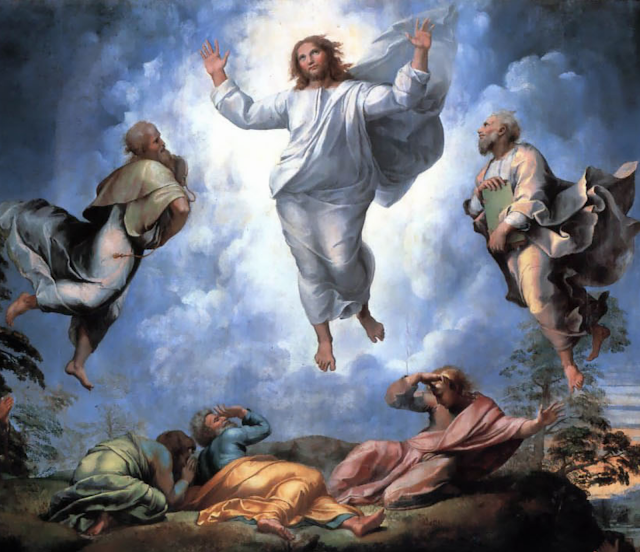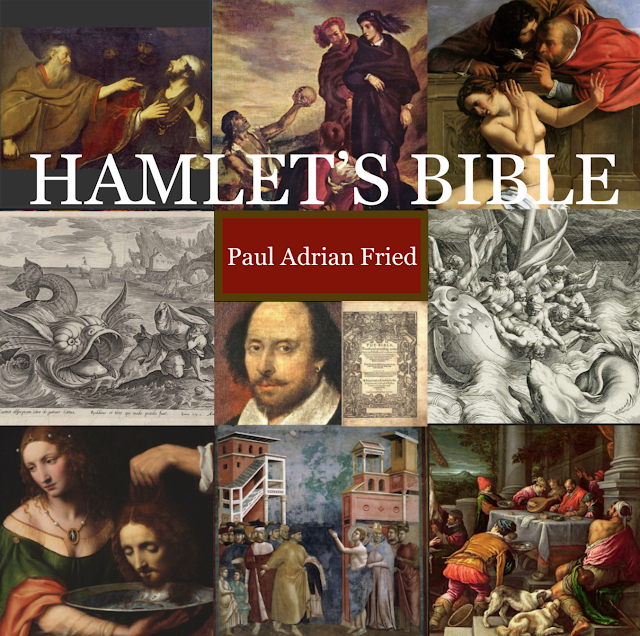DARK TRANSFIGURATION & MOSES ECHOES in HAMLET 1.4-5

[Detail from painting of the Transfiguration, by Raphael]
~~~~~~~~~~~~~~~~~~~~~~~~~~~~~~~~~~~~~~~~~~~~~~~~~~~~~~~~~~~~
In Hamlet’s meeting with the ghost in act 1, scenes 4-5, there is a dark and ironic variation on the Transfiguration, as told in the gospels (Mt 17:1–, Mk 9:2–, Lk 9:28–):
Gospels: Jesus goes up on a mountain with three disciples: James, Peter, and the beloved John.
Hamlet: the prince initially gets news of the ghost from three: Marcellus, Bernardo, and beloved friend Horatio.
- All three, plus Hamlet, speak of Hamlet keeping watch with them that night, like Jesus with James, Peter, and the beloved John.
Later, perhaps for dramatic efficiency's sake, Bernardo does not join them for the watch, so Hamlet goes to meet the ghost with only two, Horatio and Marcellus.
Gospels: Jesus is transfigured in light and speaks with Elijah and Moses.
Hamlet wears black and is darkly transfigured toward madness and revenge after speaking with the ghost who claims to be his father.
Both Jesus and Hamlet ask the other witnesses not to speak of what they witnessed.
In both Hamlet and the gospels, a supernatural voice addresses the witnesses:
Gospels: some variation of “This is my beloved son; listen to him.”
Hamlet: the ghost tells the witnesses, “Swear” (to secrecy).
In 1.4, Horatio warns Hamlet that the ghost may tempt him “to the dreadful summit of the cliff,” which also echoes the temptation of Christ, where, in one part, the devil takes Jesus to the pinnacle of the temple and tells him to throw himself down, saying angels would save him.
The biblical transfiguration story of Jesus echoes the older tale of Moses going up on the mountain to receive the tablets of the law: In her book, Thinking with Shakespeare, Julia Reinhard Lupton notes that Hamlet is like Moses: Hamlet says he will erase all other thoughts from the tables of his memory and remember only what the ghost has told him, and yet like Israel, Hamlet forgets and goes astray. Furthermore, the ghost is being punished, so the audience should feel some cognitive dissonance in the idea that the ghost represents a law-giving God. In a now-outdated sense of the Hebrew scriptures ("Old Testament") as representing the old law, and the Christian Scritpures ("New Testament") as representing the new, the ghost tells Hamlet to seek revenge ("an eye for an eye"), but after the sea-voyage, Hamlet needs to find a better way that includes reconciliation with Laertes and reparations with Fortinbras. This would have fit with the basic Elizabethan attitudes about Christianity in relation to Judaism.
How might all of this color our reading of these scenes and of the play?
~~~~~~~~~~~~~~~~~~~~~~~~~~~~~~~~~~~~~~~~~~~~~~~~~~~~~~~~~~~~
I have a déjà vu that I may have read a reference by some Shakespeare scholar to this Transfiguration echo in Hamlet 1.4-5. If you are familiar with such a reference, please comment, email or DM me.
~~~~~~~~~~~~~~~~~~~~~~~~~~~~~~~~~~~~~~~~~~~~~~~~~~~~~~~~~~~~
Some early speculation of the significance of this dark Transfiguration echo:
1. It's hard to restrict one's reading of Hamlet 1.4-5 and other scenes to a strictly secular or even, say, Freudian interpretation once you notice the dark echo of the Transfiguration here, and similar biblical influences elsewhere, IMO. Shakespeare lived at a time when reading the bible was VERY popular, and it was in the vernacular for only a generation or two, so exclusively secular readings of this and other scenes may unnaturally impose a modern secularity onto a text that was written in a hotbed of religious controversy and religious interest.
2. Sometimes Protestants and Catholics are both guilty of cherry-picking the texts for details that suit a very narrow Christian reading in harmony with their own religious-ideological biases; but once one notices this and certain other biblical echoes, it's harder (IMO) for some Catholic interpreters to claim the ghost IS from purgatory, and sent with God's permission, and that the ghost, therefore (as some of them claim) is not a demon in disguise. Noticing the dark echo of the Transfiguration, and therefore the probability that the ghost is evil in some way, itself doesn't prove or disprove the existence of purgatory, etc., but in this play, may rule out that narrow Catholic interpretation. There are other (very different) readings of the play by professed Catholics, but assuming the ghost is from purgatory becomes very strained in this case.
3. Protestant assumptions of the time and of the English church included the ideas there are no ghostly visitations, there is no purgatory, and that if it seems you're visited by a ghost, it must be a demon in disguise; but because 1.5 especially echoes the transfiguration, it points to that gospel story and the fact that the ghosts or spirits of Elijah and Moses appeared to Jesus on the mountain of transfiguration. Luther said, "Scripture alone!" but the appearance of Elijah and Moses, long dead, to Jesus, Peter, James, and John, was in fact biblical. So this implies in the background something like Shakespeare talking back to Protestant assumptions, implying that visitation by spirits of the dead is, in fact, biblical, while still affirming the Protestant assumption (a demon in disguise) via the dark, ironic echo in this particular scene.
4. Whereas the gospel transfiguration accounts are happy, hopeful, and bathed in light, the Hamlet echo of it is very dark, focused on sin, corruption. punishments in the afterlife, revenge, and impending madness (which Horatio notices even before the end of 1.5 in Hamlet's whirling words). The play seems to assert against the scripture story that, besides Jesus being transfigured in light, people can be transfigured in terrible ways by revenge.
5. We may also learn about Shakespeare's allusive practice from this echo: In act 1, scene 1, Horatio was presented as a kind of doubting Thomas figure, resisting any belief that the sentinels had seen a ghost. And if Horatio is presented in 1.1 as a doubting Thomas, this implies that maybe the Ghost is a potential Christ-figure.
- But now in 1.4, Horatio implies the ghost may be like the Devil who tempted Christ by bringing him to the pinnacle of the temple in Jerusalem and telling him he should throw himself off, because angels would catch him. That would be suicide, a strong theme in Hamlet.
- And in the parallel to the Transfiguration story in 1.4-5, Horatio seems to fit the role of the beloved disciple John, no longer Thomas the doubter. The Ghost, who was a potential Christ figure to the doubting Horatio, is now feared by Horatio to be a demon.
So this is part of Shakespeare's creative genius: he shifts his allegorical references around, so Horatio, who was like a doubting Thomas in 1.1 is like the beloved disciple John in 1.4-5, and the ghost that was like a potential Christ figure in 1.1 is now a potential demon and tempter. Shakespeare in that way is like a juggler who keeps many pins moving in the air, and the mirror he holds up at one point shifts to a new mirror later.
~~~~~~~~~~~~~~~~~~~~~~~~~~~~~~~~~~~~~~~~~~
Disclaimer: By noting bible passages in this blog, I am not intending to promote any religion over any other, nor am I attempting to promote religious belief in general. Only to point out how the Bible may have influenced Shakespeare, his plays, and his age.
~~~~~~~~~~~~~~~~~~
THANKS FOR READING!
~~~~~~~~~~~~~~~~~~~~~~~~~~~~~~~~~~~~~~
My current project is a book tentatively titled Hamlet’s Bible, about biblical allusions and plot echoes in Hamlet.
Below is a link to a list of some of my top posts (“greatest hits”), including a description of my book project (last item on the list):
https://pauladrianfried.blogspot.com/2019/12/top-20-hamlet-bible-posts.html
I post every week, so please visit as often as you like and consider subscribing.

Comments
Post a Comment